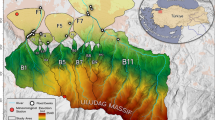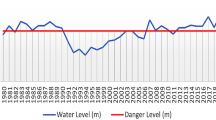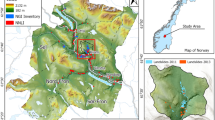Abstract
It is well known that geological structure is one of the main predisposing factors that control landslide occurrence at regional scale. Along time, investigation of the role of structural and lithologic controls has raised the interest of specialists from various earth and planetary sciences who proposed different approaches that range from descriptive analysis to automatic detection. The aim of this study is to investigate the role of structural and lithological controls on landslide occurrence at regional scale. To achieve this, a collection of tools for calculating the TOBIA index and estimating the relationship between morphostructural and lithological conditions and landslide occurrences was developed using Python programming language. The relationship between geological structure and landslide occurrences was analyzed in three distinct landslide-prone sites in Romania, located in different geological and geomorphological contexts. The spatial distribution of the geological structure is modelled based on the TOBIA index (TOpographic/Bedding-plane Intersection Angle). The TOBIA index uses topographic slope, slope aspect, dip angle, and dip direction to divide the terrain into three categories named cataclinal, anaclinal, and orthoclinal, with each category having several subcategories. Additionally, by implementing the bivariate statistical analyses (Weight of Evidence), we investigated the relationship of landslide occurrences to the resulted morphostructural slopes, on the one hand, and to the lithological units, on the other hand. The output contrast values show an evident influence of the cataclinal slopes over landslide occurrences in homoclinal areas, with most of the scarps occurring at the contact between cataclinal and orthoclinal slopes. Fewer influences are found in areas where clay outcrops and where the geological structure has a much-diminished control over the presence of the landslides. These results contribute to a better understanding of the role of structural and lithologic controls on landslide occurrence at regional scale and furthermore could serve to a better assessment of landslide susceptibility. The results obtained on different geologic and geomorphic contexts in Romania suggest that this methodology can be applied successfully in other areas prone to landslides. For reproducibility purposes, the GIS set of tools was made available under the MIT license.















Similar content being viewed by others
Change history
23 June 2022
A Correction to this paper has been published: https://doi.org/10.1007/s10346-022-01928-1
References
Barton ME (1977) Landsliding along bedding planes. Bull Int Assoc Eng Geol - Bull L’association Int Géologie L’ingénieur 16:5–7. https://doi.org/10.1007/BF02591432
Bonham-Carter GF, Agterberg FP, Wright DF (1989) Weights of evidence modelling: a new approach to mapping mineral potential. In: Agterberg FP, Bonham GF (ed) Statistical applications in the Earth Sciences. Geological Survey of Canada, Paper 89–9. pp 171–183
Bromhead EN, Ibsen LM (2007) An overview of landslide problems in the British Isles, with reference to geology, geography and conservation. In: Sassa K, Fukuoka H, Wang F, Wang G (eds) Progress in landslides science. pp 13–26
Bromhead EN, Ibsen ML (2004) Bedding-controlled coastal landslides in Southeast Britain between Axmouth and the Thames Estuary. Landslides 1:131–141. https://doi.org/10.1007/s10346-004-0015-3
Cencetti C, De Rosa P, Fredduzzi A, Marchesini I, Minelli A (2009) Automazione nel calcolo della mappa dell’indice TOBIA per la realizzazione di una cartografia di propensione al dissesto (Automate calculus of TOBIA for mapping susceptibility to slope failures). In: Atti 13a Conferenza Nazionale ASITA - Bari 1–4 dicembre 2009. pp 655–662
Chen CH, Ke CC, Wang C (2009) A back-propagation network for the assessment of susceptibility to rock slope failure in the eastern portion of the Southern Cross-Island Highway in Taiwan. Environ Geol 57:723–733. https://doi.org/10.1007/s00254-008-1350-9
Chigira M, Wang G, Wu X (2012) Landslides induced by the Wenchuan earthquake. In: Clague JJ, Stead D (eds) Landslides types, mechanism and modelling. Cambridge University Press, pp 383–392
Chițu Z (2010) Predicția spațio-temporală a hazardului la alunecări de teren utilizând tehnici S.I.G. Studiu de caz arealul subcarpatic dintre Valea Prahovei și Valea Ialomiței (Spatio-temporal prediction of landslide hazard using GIS. Case study: the Subcarpathians between the Prahova and the Ialomita Valleys). Manuscript PhD thesis, Universitatea din București, pp 277
Chițu Z, Istrate A, Adler MJ, Șandric I, Olariu B, Mihai B (2015) Comparative study of the methods for assessing landslide susceptibility in Ialomiţa Subcarpathians, Romania. In: Engineering Geology for Society and Territory, IAEG XII Congress Volumes, 2014. Springer Verlag, pp 1205–1209. https://doi.org/10.1007/978-3-319-09057-3_211
Chițu Z, Bogaard T, Busuioc A, Burcea S, Șandric I, Adler MJ (2017) Identifying hydrological pre-conditions and rainfall triggers of slope failures at catchment scale for 2014 storm events in the Ialomita Subcarpathians, Romania. Landslides 14:419–434. https://doi.org/10.1007/s10346-016-0740-4
Cruden DM (1985) Rock slope movements in the Canadian Cordillera. Can Geotech J 22:528–540. https://doi.org/10.1139/t85-073
Cruden DM (2000) Some forms of mountain peaks in the Canadian Rockies controlled by their rock structure. Quat Int 68–71:59–65. https://doi.org/10.1016/S1040-6182(00)00032-X
Cruden DM, Hu XQ (1994) Topples on underdip slopes in the Highwood Pass, Alberta, Canada. Q J Eng Geol 27:57–68. https://doi.org/10.1144/GSL.QJEGH.1994.027.P1.08
Cruden DM, Hu XQ (1996) Hazardous modes of rock slope movement in the Canadian Rockies. Environ Eng Geosci 2:507–516. https://doi.org/10.2113/gseegeosci.II.4.507
Dikau R, Brunsden D, Schrott L, Ibsen M-L (1996) Landslide recognition: identification, movement and causes. John Wiley, Chichester, p 274
Dinu M (1996) The relationship between landslides and slope evolution in the Vâlcea Subcarpathians, Romania. Geogr Fis Din e Quat 19:227–232
Dinu M (1999) Subcarpații dintre Topolog și Bistrița Vâlcii (The Subcarpathians between the Topolog and the Bistrița Vâlcii valleys), Editura Academiei Române, București, pp 212
Dragoș V (1957) Deplasări de teren (Mass movements). Editura Științifică, București, pp 164
Dykes AP, Bromhead EN, Hosseyni SM, Ibsen M (2013) A geomorphological reconnaissance of structurally-controlled landslides in the Dolomites. Ital J Eng Geol Environ. https://doi.org/10.4408/IJEGE.2013-06.B-10
ESRI (2017) ArcGIS Pro. https://www.esri.com/en-us/arcgis/products/arcgis-pro/overview
Fell R, Stapledon D, MacGregor P (2012) Landslides and geologic environments. In: Clague JJ, Stead D (eds) Landslides, type, mechanisms and modeling. pp 134–143
Geertsema M, Clague JJ, Schwab JW, Evans SG (2006) An overview of recent large catastrophic landslides in northern British Columbia, Canada. Eng Geol 83:120–143. https://doi.org/10.1016/j.enggeo.2005.06.028
Genevois R, Ghirotti M (2005) The 1963 Vaiont landslide. G Di Geol Appl 1:41–52. https://doi.org/10.1474/GGA.2005-01.0-05.0005
Gheuca I (1988) Versantul sudic al Munţilor Făgăraş. Litostratigrafie şi tectonică. (The southern slope of the Făgăraș Mountains - Lithostratigraphy and tectonics). Dări Seamă 72–73:93–117
Grelle G, Revellino P, Donnarumma A, Guadagno FM (2011) Bedding control on landslides : a methodological approach for computer-aided mapping analysis. Nat Hazards Earth Syst Sci 11:1395–1409. https://doi.org/10.5194/nhess-11-1395-2011
Gugiuman I (1937) Alunecări de straturi și scurgeri de gloduri pe Valea Bârladului și Crasnei (Jud. Fălciu) (Landslides and earthflows in the Bârlad and Crasna valleys). BSRRG LV:176–180
Günther A (2003) SLOPEMAP: programs for automated mapping of geometrical and kinematical properties of hard rock hill slopes. Comput Geosci 29:865–875. https://doi.org/10.1016/S0098-3004(03)00086-4
Günther A, Carstensen A, Pohl W (2004) Automated sliding susceptibility mapping of rock slopes. Nat Hazards Earth Syst Sci 4:95–102. https://doi.org/10.5194/nhess-4-95-2004
Guzzetti F, Cardinali M, Reichenbach P (1996) The influence of structural setting and lithology on landslide type and pattern. Environ Eng Geosci II:531–555
Has B, Nozaki T (2014) Role of geological structure in the occurrence of earthquake-induced landslides, the case of the 2007 Mid-Niigata Offshore Earthquake, Japan. Eng Geol 182:25–36. https://doi.org/10.1016/j.enggeo.2014.09.006
Hu XQ, Cruden DM (1992) Rock mass movements across bedding in Kananaskis Country, Alberta. Can Geotech J 29:675–685. https://doi.org/10.1139/t92-074
Ilinca V (2012) Inventarierea alunecărilor de teren și zonarea susceptibilității în depresiunile Brezoi-Titești și Poiana (Landslide inventory and susceptibility zonation in the Brezoi-Titești and Poiana depressions). In: Simpozionul Național de Geomorfologie, ediția a XXVIII-a, Baru, 14–17 iunie. pp 27
Isaaks HE, Srivastava RM (1989) Applied geostatistics. Oxford University Press, Oxford, p 592
Jurchescu M (2012) Bazinul Oltețului - Studiu de geomorfologie aplicată (The Olteț drainage basin. An applied geomorphological study), Manuscript PhD thesis, Universitatea din București, pp 470
Lee S, Chwae U, Min K (2002) Landslide susceptibility mapping by correlation between topography and geological structure: the Janghung area, Korea. Geomorphology 46:149–162. https://doi.org/10.1016/S0169-555X(02)00057-0
Macovei G, Botez G (1923) Comunicare asupra fenomenelor de alunecări și prăbușiri de teren din județul Râmnicul-Sărat (Report on landslides and falls in the Râmnicul-Sărat County). Dări Seamă VI:178–184
Marchesini I, Mergili M, Rossi M, Santangelo M, Cardinali M, Ardizzone F, Fiorucci M, Schneider-Muntau B, Fellin W, Guzzetti F (2014) A GIS approach to analysis of deep-seated slope stability in complex geology. In: Landslide Science for a Safer Geoenvironment: Volume 2: Methods of Landslide Studies. pp 483–489. doi: https://doi.org/10.1007/978-3-319-05050-8_75
Marchesini I, Santangelo M, Fiorucci F, Cardinali M, Rossi M, Guzzetti F (2011) A GIS method for obtaining geologic bedding attitude. In: Proceedings of the Second World Landslide Forum, 3–7 October. Rome, pp 1–4
Mărgărint MC, Niculiţă M (2017) Landslide type and pattern in Moldavian Plateau, NE Romania. In: Springer Geography. Springer, pp 271–304. https://doi.org/10.1007/978-3-319-32589-7_12
Meentemeyer RK, Moody A (2000) Automated mapping of conformity between topographic and geological surfaces. Comput Geosci 26:815–829. https://doi.org/10.1016/S0098-3004(00)00011-X
Micu M (2017) Landslide types and spatial pattern in the Subcarpathian area. In: Rădoane M, Vespremeanu-Stroe A (eds) Landform Dynamics and Evolution in Romania. Springer, pp 305–326. https://doi.org/10.1007/978-3-319-32589-7_13
Mihăilă N (1970) Deplasările de teren din interfluviul Olt-Vîlsan și locul lor în clasificarea actuală (Landslides in the Olt-Vîlsan interfluve and their typology). Stud Teh și Econ F:43–64
Müller L (1987) The Vajont catastrophe—a personal review. Eng Geol 24:423–444. https://doi.org/10.1016/0013-7952(87)90078-0
Nichiforescu H, Panaitescu P, Panaitescu M, Lubenescu V (1985) Prospecțiuni geologice pentru cărbuni în depozitele mio-pliocene din Depresiunea Getică, perimetrul Horezu-Vaideeni-Slătioara, județul Vîlcea, scara 1:5,000 (Geological coal prospections in the Miocene-Pliocene deposits of the Getic Depression, the Horezu-Vaideeni-Slătioara area, Vâlcea County, scale 1:5,000). București, pp 35
Nicolaescu V, Lubenescu V, Iavorschi M, Ionescu S, Damian R (1980) Contribuții la cunoașterea biostratigrafiei depozitelor Neogenului superior din regiunea Valea Ialomiței și Valea Cricovului Dulce (Contributions to the knowledge of the biostratigraphy of the Upper Neogene deposits in the region between the Ialomița and the Cricovul Dulce valleys). Dări Seamă LXV:133–146
Niculiţă M, Mărgărint MC, Cristea AI (2019) Using archaeological and geomorphological evidence for the establishment of a relative chronology and evolution pattern for Holocene landslides. PLoS ONE 14:e0227335. https://doi.org/10.1371/journal.pone.0227335
Norrish NI, Wyllie DC (1996) Rock slope stability analysis. In: Turner AK, Schuster RL (ed) Landslides investigation and mitigation. Transportation Research Board, Special Report 247. National Research Council, National Academy Press, Washington, DC, pp 391–425
Paronuzzi P, Bolla A (2012) The prehistoric Vajont rockslide: an updated geological model. Geomorphology 169–170:165–191. https://doi.org/10.1016/j.geomorph.2012.04.021
Peahă M (1946) Asupra alunecării de straturi pe pantă structurală în regiunea Blaj (Jud. Argeș) (Report on the structural landslide in the Blaj region, Argeș County). Rev Geogr III:266–274
Pinto F, Guerriero L, Revellino P, Grelle G, Senatore MR, Guadagno F (2016) Structural and lithostratigraphic controls of earth-flow evolution, Montaguto earth flow, Southern Italy. J Geol Soc London. https://doi.org/10.1144/jgs2015-081
Popescu B, Szász L, Hann HP, Schuster A (1977) Harta geologică a României scara 1:50000, foaia Călimănești (Geological map of Romania, scale 1:50.000, Călimănești – Map sheet). Institutul Geologic al României, București
Popescu G (1954) Cercetări geologice în regiunea Govora - Râmnicu-Vâlcea - Olănești (Depresiunea Getică) (Geological research in the Govora - Râmnicu Vâlcea - Olănești region, Getic Depression). Dări Seamă XXXVIII:118–136
Popescu N (1998) Modelarea versanților prin alunecări de teren într-o regiune subcarpatică cu structură monoclinală. Valea Câlnăului în sectorul Modreni-Racovițeni (Slope modeling by landslides in a Subcarpathian area dominated by monoclinal structure. The Câlnău Valley in the Modreni-Racovițeni area). Comunicări Geogr II:22–26
Powell JW (1875) Exploration of the Colorado River of the West and its tributaries. U.S. Govt. Printing Office, Washington, DC, pp 291
Roering JJ, Kirchner JW, Dietrich WE (2005) Characterizing structural and lithologic controls on deep-seated landsliding: implications for topographic relief and landscape evolution in the Oregon Coast Range, USA. GSA Bull 117:654–668. https://doi.org/10.1130/B25567.1
Şandric I, Chiţu Z (2009) Landslide inventory for the administrative area of Breaza, curvature subcarpathians, România. J Maps 5:75–86. https://doi.org/10.4113/jom.2009.1051
Șandric I, Ioniță C, Chițu Z, Dardala M, Irimia R, Furtuna FT (2019) Using CUDA to accelerate uncertainty propagation modelling for landslide susceptibility assessment. Environ Model Softw 115:176–186. https://doi.org/10.1016/j.envsoft.2019.02.016
Santangelo M, Marchesini I, Cardinali M, Fiorucci F, Rossi M, Bucci F, Guzzetti F (2015) A method for the assessment of the influence of bedding on landslide abundance and types. Landslides 12:295–309. https://doi.org/10.1007/s10346-014-0485-x
Selby MJ (1993) Hillslope materials and processes. Oxford University Press, pp 480
Skempton AW (1966) Bedding-plane slip, residual strength and the Vajont landslide. Géotechnique 16:82–84
Smale D, Van Der Lingen GJ, Bell DH (1982) A bedding-plane landslide near Mt Vulcan, North Canterbury. New Zeal J Geol Geophys 25:397–404. https://doi.org/10.1080/00288306.1982.10421506
Ștefănescu M, Ghenea C, Papaianopol I, Ghenea A, Mihăilescu N, Ivan V, Munteanu T, Ștefănescu M, Munteanu E (1988) Harta geologică a României, scara 1:50,000, foaia Pucioasa (Geological map of Romania, scale 1:50,000, Pucioasa – Map sheet). Institutul Geologic al României, București
Ștefănescu M, Hann HP, Gheuca I, Szàsz L, Ștefănescu M (1982a) Harta geologică a României, scara 1:50,000, foaia Titești (Geological map of Romania, scale 1:50,000, Titești – Map sheet). Institutul Geologic al României, București
Ștefănescu, M., Polonic, P., Berza, T., Hann, H., Balintoni, I., Popescu, I., Ionescu, F., Niculin, M., Popescu-Brădet, L., & Constantinescu, L. (1988). Secțiune geologică Tăul Zăului-Bogata-Ocna Sibiului-Poplaca-Românii de Sus-Horezu-Tetoiu-Călinești-Malu Mare (A-B). Institutul Geologic al României, Bucureşti
Ștefănescu M, Szàsz L, Hann HP, Gheuca I, Ștefănescu M, Bratu E, Piliuță A-M (1982b) Harta geologică a României, scara 1:50,000, foaia Titești - Raport (Geological map of Romania, scale 1:50,000, Titești - Explanation notes). Institutul Geologic al României, București, pp 22
Szász L (1976) Biostratigrafia și paleontologia cretacicului superior din Bazinul Brezoi (Carpații Meridionali) (Biostratigraphy and paleontology of the Upper Cretaceous from the Brezoi Basin, Southern Carpathians). Dări Seamă LXII:189–220
Xu B, Yan C, Xu S (2013) Analysis of the bedding landslide due to the presence of the weak intercalated layer in the limestone. Environ Earth Sci 70:2817–2825. https://doi.org/10.1007/s12665-013-2341-z
Záruba Q, Mencl V (1982) Landslides and their control. Second completely revised edition. Elsevier BV, pp 324
Zberea A, Zberea M, Ghiu T, Sârbu F, Oprea M (1963) Raport de prospecțiuni geologice pentru cărbuni în regiunea dintre Valea Oltețului și Valea Otăsăului (Report on geological prospections for coal in the area located between the Olteț and the Otăsău valleys). Comitetul Geologic, București, pp 62
Zberea A, Zberea M, Socoleanu D (1969) Sinteza lucrărilor de cercetare geologică pentru cărbuni în zona neogenă, între Dunăre și Valea Oltului (sectorul v. Olteț-v. Otăsău) județul Gorj și Vîlcea (The synthesis of geological research on coal in the Neogene area between the Danube and the Olt valleys, the sector Olteț-Otăsău valleys). Comitetul de Stat al Geologiei, București, pp 136
Zȇzere JL (2002) Landslide susceptibility assessment considering landslide typology. A case study in the area north of Lisbon (Portugal). Nat Hazards Earth Syst Sci 2:73–82. https://doi.org/10.5194/nhess-2-73-2002
Author information
Authors and Affiliations
Corresponding author
Additional information
The original online version of this article was revised: The published version of this article contains an error. The authors noticed that an incorrect reference was cited in page 3 and a new reference should be added in the reference list. The correct reference for Ștefănescu et al. 1988 cited in page 3 is: Ștefănescu, M., Polonic, P., Berza, T., Hann, H., Balintoni, I., Popescu, I., Ionescu, F., Niculin, M., Popescu-Brădet, L., & Constantinescu, L. (1988). Secțiune geologică Tăul Zăului-Bogata-Ocna Sibiului-Poplaca-Românii de Sus-Horezu-Tetoiu-Călinești-Malu Mare (A-B). Institutul Geologic al României, Bucureşti. The original article has been corrected.
Rights and permissions
About this article
Cite this article
Ilinca, V., Şandric, I., Jurchescu, M. et al. Identifying the role of structural and lithological control of landslides using TOBIA and Weight of Evidence: case studies from Romania. Landslides 19, 2117–2134 (2022). https://doi.org/10.1007/s10346-021-01749-8
Received:
Accepted:
Published:
Issue Date:
DOI: https://doi.org/10.1007/s10346-021-01749-8




